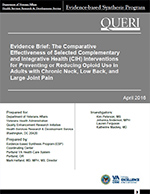
Investigators: Kim Peterson, MS; Johanna Anderson, MPH; Lauren Ferguson; Katherine Mackey, MD
Download PDF: Brief, Supplement
The objective of this evidence brief is to summarize the evidence on the effectiveness of select Complementary and Integrative Health (CIH) interventions (acupuncture, massage, meditation, tai chi, and yoga) for reducing opioid use in adults with chronic neck, low back, and large joint pain. The ESP Coordinating Center investigators and representatives of the SOTA committee worked together to identify the population, interventions, comparators, outcomes, timing, setting, and study design characteristics of interest. The SOTA committee approved the following key questions and eligibility criteria to guide this review:
Key Question 1: In adults with chronic neck, low back, and large joint pain who have never used opioids, what is the comparative effectiveness of selected CIH interventions for reducing new opioid use?
Key Question 2: In adults with chronic neck, low back, and large joint pain who have never used opioids, what are the comparative harms of selected CIH interventions for reducing new opioid use?
Key Question 3: In adults with chronic neck, low back, and large joint pain who have never used opioids, how do the comparative effects of selected CIH interventions for reducing new opioid use vary depending on: (1) the specific type or location of pain; (2) patient demographics (eg, age, race, ethnicity, gender); (3) patient comorbidities (including past or current alcohol or substance use disorders, mental health disorders, medical comorbidities, and high risk for addiction)?
Key Question 4: In adults using opioids for chronic neck, low back, and large joint pain, what is the comparative effectiveness of selected CIH interventions for reducing opioid use?
Key Question 5: In adults using opioids for chronic neck, low back, and large joint pain, what are the comparative harms of selected CIH interventions for reducing opioid use?
Key Question 6: In adults using opioids for chronic neck, low back, and large joint pain, how do the comparative effects of selected CIH interventions for reducing new opioid use vary depending on: (1) the specific type or location of pain; (2) patient demographics (eg, age, race, ethnicity, gender); (3) patient comorbidities (including past or current alcohol or substance use disorders, mental health disorders, medical comorbidities, and high risk for addiction)?